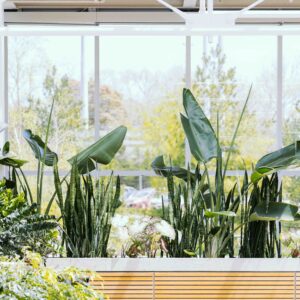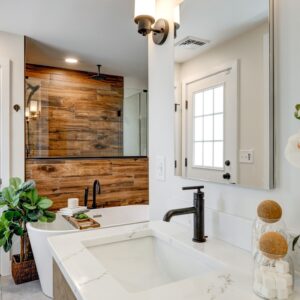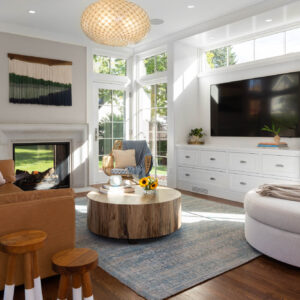With spring right around the corner, many Montgomery County homeowners long to get back outside, feel the sun’s warmth and reconnect with nature. Staying closed up inside all winter can make anyone feel weary and claustrophobic — after all, it’s in our DNA to feel calm and connected when we’re in the great outdoors.
But what if you didn’t need to wait until warmer months to experience the natural environment? What if you brought nature into your home to enjoy year-round? This idea is called biophilic design, a growing movement we’re excited to participate in. In this blog, we’ll explore this captivating design philosophy and its benefits, and unveil practical ways to incorporate it into your home.
What Is Biophilic Design?
Biophilic design aims to reconnect humans with nature indoors and is inspired by the innate human draw towards the natural world. Stemming from the Greek word “biophilia,” meaning love of nature, biophilic design aims to reconnect humans with nature in our modern buildings and cities. This could be as simple as bringing in more houseplants or as involved as adjusting the architecture of your home to incorporate more organic shapes.

Benefits of Biophilic Design
Biophilic design can be aesthetically pleasing and a good match for certain style preferences, but incorporating nature in your home goes beyond good looks. It can foster:
Better Health: Studies have shown that experiencing nature has several therapeutic effects, including reducing stress levels, lowering blood pressure, elevating mood, and balancing circadian rhythms.
Better Productivity: Biophilic design is not only embraced by homeowners but also by businesses and schools seeking to boost efficiency and innovation. Exposure to nature has been shown to improve attention span, creativity, cognitive performance, and employee satisfaction.
Better Sustainability: It’s no surprise that designing with nature in mind is also generally good for the environment. Materials in line with biophilic design tend to be more sustainable since they are often minimally processed and renewable, and opting for natural light reduces the use of electricity.
The Three Pillars of Biophilic Design
To create spaces that foster well-being, improve productivity, and promote a sense of tranquility, biophilic design relies on three fundamental pillars.

1: Nature in the Space
The first pillar of biophilic design involves incorporating tangible, real-life elements of nature into your home. You could use natural materials such as wood, stone, or glass, bring in a plethora of houseplants, or consider building out large or numerous windows to maximize natural light. Other ideas include:- Water features, like a trickling fountain
- Minimally processed or raw materials that emphasize natural features like woodgrains
- Indoor herb gardens or green walls Incorporating natural decorative items like shells, stones, or driftwood
2. Natural Analogues
The second pillar of biophilic design focuses on manufactured items that emulate patterns, textures, and colors found in nature. By mimicking natural elements such as sunlight, foliage, and organic shapes, homeowners can evoke a sense of calm and balance. Here are a few examples:
- Neutral paint colors
- Wallpaper, tile, or countertops with a nature theme or pattern
- Natural fabrics and materials like cotton, hemp, linen, or wool
- Circular or organically shaped furniture like tables, mirrors, rugs, and other decor



